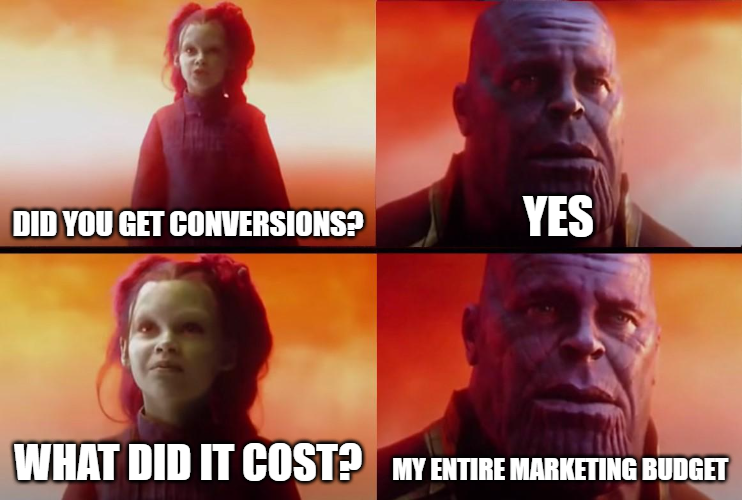Everyone loves big numbers! Big numbers make the charts point in the right direction. Big numbers turn green and give us that warm fuzzy feeling that all is well.
Big numbers always mean we’re successful... Right?

Using the ‘Big Number = Better’ logic can sometimes provide you with a false sense of performance because it can lack an important component – Context. If your Sales Lead tells you they hit $1,000,000 in Sales last quarter but fails to mention how they cut their margin to hit that sales number, you'd probably feel more concerned than excited.
The same can be said about your SEM Campaign. If you were told your search campaign had a 15% click-through rate (CTR) last month, you’d likely think that your campaign is doing exceptionally well! But digging into the numbers a bit further, you find that your campaign only received 100 impressions (and therefore 15 clicks).
Getting a better sense of your SEM campaign metrics and how they relate to one another can give you the context you need to evaluate its performance. Let’s look at some important metrics in your SEM campaign and how other metrics influence them.
Click through Rate (CTR)
Sticking with the first example used, CTR measures how often users click on your ad after it is shown to them. It’s a useful metric that can showcase how effective your Ad Copy and keyword targeting are at getting the right people to your website. But seeing this percentage alone without knowing the volume of clicks and impressions can paint a misleading picture. It’s better to have a 15% CTR on a campaign with 50,000 impressions vs. 500 impressions.
Conversions
Getting users to take action on your website is the end goal of most SEM campaigns. Getting that purchase, receiving contact info from a potential client, or getting the phone to ring is music to most ears. With the reporting capabilities of an SEM Campaign, we can track those conversions back to the Campaign, Ad Group, or Asset responsible for them.
But seeing the total amount of conversions generated only tells part of the story. Digging into other metrics can give you a better perception of which assets are providing you with conversions more effectively.
Conversion Rate
Conversion Rate measures how often an interaction with an asset leads to a conversion. This can help you gauge which assets lead to more conversions when clicked.
Just because one asset is providing you with a high number of conversions doesn’t mean that it’s the best. It may be utilizing a large amount of your impressions and budget to provide those conversions while other assets may be utilizing fewer resources while still providing an effective number of conversions. Conversion rate can help you see which assets are most efficient and help you identify which ones are more deserving of your time and money.
Cost/Conversion
As the name suggests, Cost/Conversion measures the average cost you pay for a conversion from an account asset. The lower the Cost/Conversion metric, the more efficient the asset is at using its budget to provide you with conversions.
This can give you more direction on which campaigns you should be spending your money on. Let’s say you want to increase sales and are willing to put additional investment towards your two SEM campaigns. Campaign A has a $10 Cost/Conversion, and Campaign B has a $70 Cost/Conversion. If you want to get the most conversions with the available budget, you’ll likely increase spend in Campaign A.
Having a Campaign or Ad Group with a high Cost/Conversion might prompt you to ask additional questions. Are you bidding on the right keywords? Is there more competition in your market than you thought? Is the high cost for a conversion justified or should we reallocate funds? These are important questions to ask and will vary depending on your goals. Conversions are important, but spending your dollars efficiently is equally important to the success of your SEM Campaign.

Conversion Value
We’ve hit on how getting conversions effectively and efficiently is important, but there is another aspect that is easy to overlook– Not all conversions are created equal!
Let’s say you own a furniture store, and three customers walk in. The first customer buys a lamp for their bedroom. The second customer purchases a mattress on display along with a new bed set. The third customer notices that you offer custom-built dining room tables and provides you with their information for a follow-up.
These three customer interactions can all be considered Conversions but provide different levels of value for your business.
The same can be said about your SEM campaign; the conversions you're tracking likely nets you different values. The beauty of an SEM campaign is that you can assign values to each conversion so you have a better sense of the value your Campaigns/Ad Groups are providing.
Enter the Conversion Value metric. This provides you with more context on the value generated from your campaigns rather than just looking at the total number of conversions.
Sticking with the previous example, let’s say you are running two Search campaigns for your furniture store. Campaign A provided you with 30 conversions while Campaign B provided 8. Just looking at the total conversions, your initial thought would be that Campaign A is your better-performing campaign and warrants additional investment. But by looking at the Conversion Value, you see that the conversions from Campaign A were all lamp purchases netting you $1,500 in value while Campaign B had 4 mattress purchases and 4 custom table requests, which nets you $15,000 in value.
Analyzing the value of your conversions in addition to the total number of conversions can help you spot the infrequent high-value actions and the lower-value lamp purchases.

Conclusion
Don’t fall into the trap of looking at a few SEM metrics and thinking ‘All is well’ in your SEM campaign. The data tells a story. Understanding what it’s trying to say requires you to analyze a combination of metrics together instead of picking and choosing the “Good Looking Metrics”.
I know that more numbers to look at can cause more confusion, but understanding the language and the story they tell can unlock a deeper understanding of your SEM campaign and help you make informed decisions.




